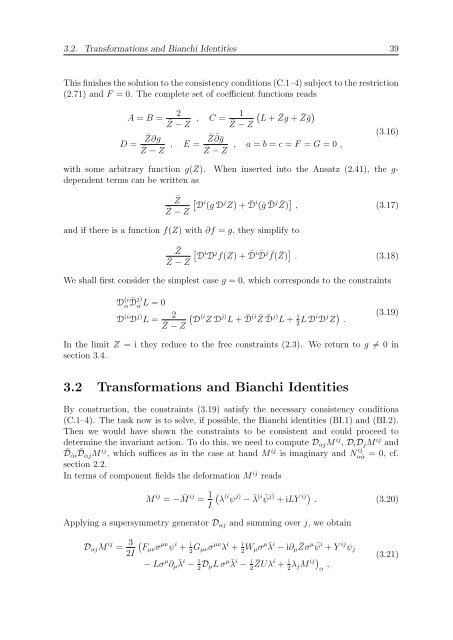N=2 Supersymmetric Gauge Theories with Nonpolynomial Interactions
N=2 Supersymmetric Gauge Theories with Nonpolynomial Interactions
N=2 Supersymmetric Gauge Theories with Nonpolynomial Interactions
Create successful ePaper yourself
Turn your PDF publications into a flip-book with our unique Google optimized e-Paper software.
3.2. Transformations and Bianchi Identities 39<br />
This finishes the solution to the consistency conditions (C.1–4) subject to the restriction<br />
(2.71) and F = 0. The complete set of coefficient functions reads<br />
A = B = 2<br />
¯Z − Z<br />
D = ¯ Z∂g<br />
¯Z − Z , E = ¯ Z ¯ ∂¯g<br />
¯Z − Z<br />
1 <br />
, C =<br />
¯Z<br />
L + Zg ¯ + Z¯g ¯<br />
− Z<br />
, a = b = c = F = G = 0 ,<br />
(3.16)<br />
<strong>with</strong> some arbitrary function g(Z). When inserted into the Ansatz (2.41), the gdependent<br />
terms can be written as<br />
¯Z i j<br />
¯Z<br />
D (g D Z) + ¯ i<br />
D (¯g ¯ j<br />
D Z) ¯ , (3.17)<br />
− Z<br />
and if there is a function f(Z) <strong>with</strong> ∂f = g, they simplify to<br />
¯Z i j<br />
¯Z<br />
D D f(Z) + ¯ i<br />
D ¯ j<br />
D f( ¯ Z) ¯ . (3.18)<br />
− Z<br />
We shall first consider the simplest case g = 0, which corresponds to the constraints<br />
D (i<br />
α ¯ D j)<br />
L = 0<br />
˙α<br />
D (i D j) L = 2<br />
¯Z − Z<br />
D (i Z D j) L + ¯ D (i ¯ Z ¯ D j) L + 1<br />
2 L Di D j Z .<br />
(3.19)<br />
In the limit Z = i they reduce to the free constraints (2.3). We return to g = 0 in<br />
section 3.4.<br />
3.2 Transformations and Bianchi Identities<br />
By construction, the constraints (3.19) satisfy the necessary consistency conditions<br />
(C.1–4). The task now is to solve, if possible, the Bianchi identities (BI.1) and (BI.2).<br />
Then we would have shown the constraints to be consistent and could proceed to<br />
determine the invariant action. To do this, we need to compute DαjM ij , DiDjM ij and<br />
¯D ˙αi ¯ DαjM ij , which suffices as in the case at hand M ij is imaginary and N ij<br />
α ˙α = 0, cf.<br />
section 2.2.<br />
In terms of component fields the deformation M ij reads<br />
M ij = − ¯ M ij = 1 (i j)<br />
λ ψ − ¯(i λ ¯j) ij<br />
ψ + iLY<br />
I<br />
. (3.20)<br />
Applying a supersymmetry generator Dαj and summing over j, we obtain<br />
DαjM ij = 3 <br />
Fµνσ<br />
2I<br />
µν ψ i + i<br />
2Gµνσ µν λ i + i<br />
2Wµσ µ¯i λ − i∂µ ¯ Zσ µ ψ¯ i ij<br />
+ Y ψj<br />
− Lσ µ ∂µ ¯ λ i − 1<br />
2 DµL σ µ¯ λ i − i<br />
2 ¯ ZUλ i + i λjM<br />
ij<br />
2 α ,<br />
(3.21)

















